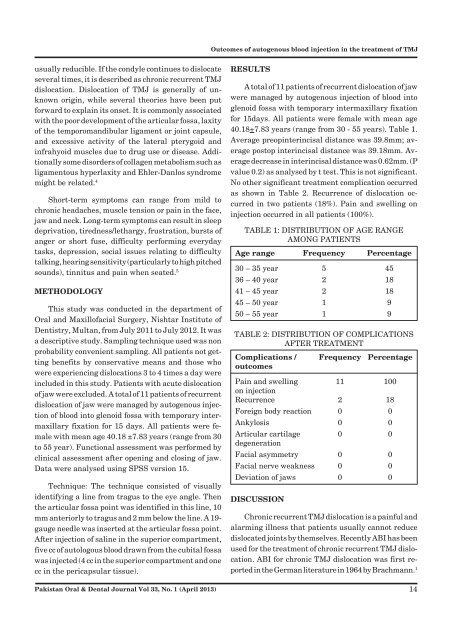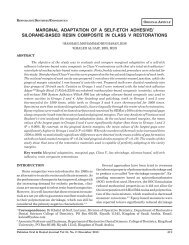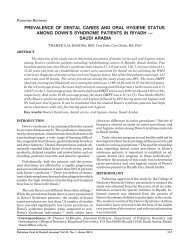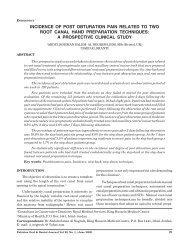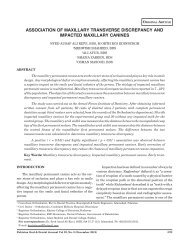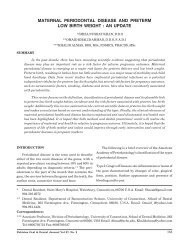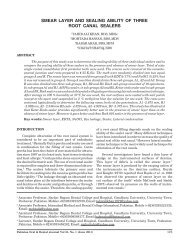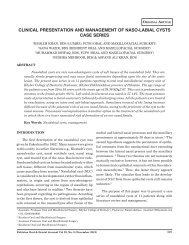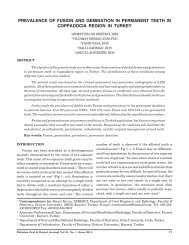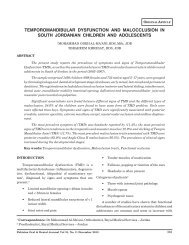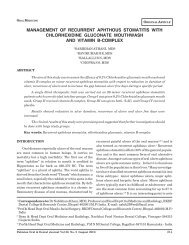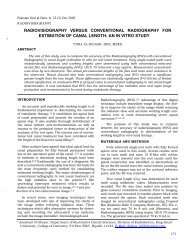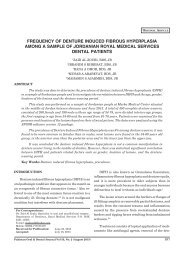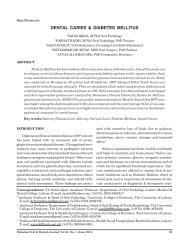outcomes of autogenous blood injection in the treatment of recurrent ...
outcomes of autogenous blood injection in the treatment of recurrent ...
outcomes of autogenous blood injection in the treatment of recurrent ...
Create successful ePaper yourself
Turn your PDF publications into a flip-book with our unique Google optimized e-Paper software.
Outcomes <strong>of</strong> <strong>autogenous</strong> <strong>blood</strong> <strong><strong>in</strong>jection</strong> <strong>in</strong> <strong>the</strong> <strong>treatment</strong> <strong>of</strong> TMJ<br />
usually reducible. If <strong>the</strong> condyle cont<strong>in</strong>ues to dislocate<br />
several times, it is described as chronic <strong>recurrent</strong> TMJ<br />
dislocation. Dislocation <strong>of</strong> TMJ is generally <strong>of</strong> unknown<br />
orig<strong>in</strong>, while several <strong>the</strong>ories have been put<br />
forward to expla<strong>in</strong> its onset. It is commonly associated<br />
with <strong>the</strong> poor development <strong>of</strong> <strong>the</strong> articular fossa, laxity<br />
<strong>of</strong> <strong>the</strong> temporomandibular ligament or jo<strong>in</strong>t capsule,<br />
and excessive activity <strong>of</strong> <strong>the</strong> lateral pterygoid and<br />
<strong>in</strong>frahyoid muscles due to drug use or disease. Additionally<br />
some disorders <strong>of</strong> collagen metabolism such as<br />
ligamentous hyperlaxity and Ehler-Danlos syndrome<br />
might be related. 4<br />
Short-term symptoms can range from mild to<br />
chronic headaches, muscle tension or pa<strong>in</strong> <strong>in</strong> <strong>the</strong> face,<br />
jaw and neck. Long-term symptoms can result <strong>in</strong> sleep<br />
deprivation, tiredness/lethargy, frustration, bursts <strong>of</strong><br />
anger or short fuse, difficulty perform<strong>in</strong>g everyday<br />
tasks, depression, social issues relat<strong>in</strong>g to difficulty<br />
talk<strong>in</strong>g, hear<strong>in</strong>g sensitivity (particularly to high pitched<br />
sounds), t<strong>in</strong>nitus and pa<strong>in</strong> when seated. 5<br />
METHODOLOGY<br />
This study was conducted <strong>in</strong> <strong>the</strong> department <strong>of</strong><br />
Oral and Maxill<strong>of</strong>acial Surgery, Nishtar Institute <strong>of</strong><br />
Dentistry, Multan, from July 2011 to July 2012. It was<br />
a descriptive study. Sampl<strong>in</strong>g technique used was non<br />
probability convenient sampl<strong>in</strong>g. All patients not gett<strong>in</strong>g<br />
benefits by conservative means and those who<br />
were experienc<strong>in</strong>g dislocations 3 to 4 times a day were<br />
<strong>in</strong>cluded <strong>in</strong> this study. Patients with acute dislocation<br />
<strong>of</strong> jaw were excluded. A total <strong>of</strong> 11 patients <strong>of</strong> <strong>recurrent</strong><br />
dislocation <strong>of</strong> jaw were managed by <strong>autogenous</strong> <strong><strong>in</strong>jection</strong><br />
<strong>of</strong> <strong>blood</strong> <strong>in</strong>to glenoid fossa with temporary <strong>in</strong>termaxillary<br />
fixation for 15 days. All patients were female<br />
with mean age 40.18 ±7.83 years (range from 30<br />
to 55 year). Functional assessment was performed by<br />
cl<strong>in</strong>ical assessment after open<strong>in</strong>g and clos<strong>in</strong>g <strong>of</strong> jaw.<br />
Data were analysed us<strong>in</strong>g SPSS version 15.<br />
Technique: The technique consisted <strong>of</strong> visually<br />
identify<strong>in</strong>g a l<strong>in</strong>e from tragus to <strong>the</strong> eye angle. Then<br />
<strong>the</strong> articular fossa po<strong>in</strong>t was identified <strong>in</strong> this l<strong>in</strong>e, 10<br />
mm anteriorly to tragus and 2 mm below <strong>the</strong> l<strong>in</strong>e. A 19-<br />
gauge needle was <strong>in</strong>serted at <strong>the</strong> articular fossa po<strong>in</strong>t.<br />
After <strong><strong>in</strong>jection</strong> <strong>of</strong> sal<strong>in</strong>e <strong>in</strong> <strong>the</strong> superior compartment,<br />
five cc <strong>of</strong> autologous <strong>blood</strong> drawn from <strong>the</strong> cubital fossa<br />
was <strong>in</strong>jected (4 cc <strong>in</strong> <strong>the</strong> superior compartment and one<br />
cc <strong>in</strong> <strong>the</strong> pericapsular tissue).<br />
Pakistan Oral & Dental Journal Vol 33, No. 1 (April 2013)<br />
RESULTS<br />
A total <strong>of</strong> 11 patients <strong>of</strong> <strong>recurrent</strong> dislocation <strong>of</strong> jaw<br />
were managed by <strong>autogenous</strong> <strong><strong>in</strong>jection</strong> <strong>of</strong> <strong>blood</strong> <strong>in</strong>to<br />
glenoid fossa with temporary <strong>in</strong>termaxillary fixation<br />
for 15days. All patients were female with mean age<br />
40.18+7.83 years (range from 30 - 55 years). Table 1.<br />
Average preop<strong>in</strong>ter<strong>in</strong>cisal distance was 39.8mm; average<br />
postop <strong>in</strong>ter<strong>in</strong>cisal distance was 39.18mm. Average<br />
decrease <strong>in</strong> <strong>in</strong>ter<strong>in</strong>cisal distance was 0.62mm. (P<br />
value 0.2) as analysed by t test. This is not significant.<br />
No o<strong>the</strong>r significant <strong>treatment</strong> complication occurred<br />
as shown <strong>in</strong> Table 2. Recurrence <strong>of</strong> dislocation occurred<br />
<strong>in</strong> two patients (18%). Pa<strong>in</strong> and swell<strong>in</strong>g on<br />
<strong><strong>in</strong>jection</strong> occurred <strong>in</strong> all patients (100%).<br />
TABLE 1: DISTRIBUTION OF AGE RANGE<br />
AMONG PATIENTS<br />
Age range Frequency Percentage<br />
30 – 35 year 5 45<br />
36 – 40 year 2 18<br />
41 – 45 year 2 18<br />
45 – 50 year 1 9<br />
50 – 55 year 1 9<br />
TABLE 2: DISTRIBUTION OF COMPLICATIONS<br />
AFTER TREATMENT<br />
Complications / Frequency Percentage<br />
<strong>outcomes</strong><br />
Pa<strong>in</strong> and swell<strong>in</strong>g 11 100<br />
on <strong><strong>in</strong>jection</strong><br />
Recurrence 2 18<br />
Foreign body reaction 0 0<br />
Ankylosis 0 0<br />
Articular cartilage 0 0<br />
degeneration<br />
Facial asymmetry 0 0<br />
Facial nerve weakness 0 0<br />
Deviation <strong>of</strong> jaws 0 0<br />
DISCUSSION<br />
Chronic <strong>recurrent</strong> TMJ dislocation is a pa<strong>in</strong>ful and<br />
alarm<strong>in</strong>g illness that patients usually cannot reduce<br />
dislocated jo<strong>in</strong>ts by <strong>the</strong>mselves. Recently ABI has been<br />
used for <strong>the</strong> <strong>treatment</strong> <strong>of</strong> chronic <strong>recurrent</strong> TMJ dislocation.<br />
ABI for chronic TMJ dislocation was first reported<br />
<strong>in</strong> <strong>the</strong> German literature <strong>in</strong> 1964 by Brachmann. 1<br />
14


